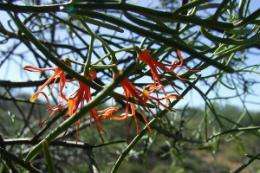Pilbara mistletoe faces sub-regional extinction

A new study from the Department of Environment and Conservation suggests long-term modern fire regimes could pose a threat to WA mistletoes (Loranthaceae sp).
Single fires ignited by lightning, arson or by prescribed burning often destroy thousands of hectares in the region. This scale of damage poses a problem for mistletoe species because of their physical vulnerability and regeneration methods.
Across species, mistletoe foliage and fresh seed are killed when scorched.
As none have a mechanism of long-term in situ seed storage and limited capacity for long-distance seed dispersal, they are highly dependent on seed being imported and deposited in burnt areas by avian populations.
Given the increasingly vast range of fire damage, regeneration is at risk.
According to study author Dr. A.N. Start, “when pastoralists settled the area little more than a century ago, radical changes were imposed on land tenure...”
“Former fire regimes were abandoned and fire was used for novel purposes, including the manipulation of pastures.
“Anthropogenic fire is still common across northern and central Australia where the trend has been to hotter and more extensive burns.”
Dr. Start notes that concern about the environmental effects of long-term, modern fire regimes has been present since the 1980s and mistletoes appear to be one group adversely affected.
Mistletoe varieties comprise a key component of Pilbara biodiversity, with many insects dependant on them for larval food, including butterfly genera Ogyris (Lycenidae) and Delias (Pieridae).
Mistletoe also support the highly adapted mistletoebird (Dicaeum hiundinaceum) as well as spiny-cheeked and grey honeyeaters, important pollinators within the region.
Though there’s no evidence of an extinction threat at the bioregional or national level, there has been subregional contraction, especially where modern fire regimes for highly flammable hummock grasslands exist.
“The outlook is bleak for mistletoes growing in areas dominated by hummock grasslands,” Dr. Start says.
“Subregional extinction is likely and there are broader implications for biodiversity.”
The study found that mistletoe have adapted to fire risk in various and imperfect ways.
Twelve taxa reduce risk by favoring hosts that grow in fire-sheltered sites. However, when host stems are killed, the length of host reestablishment often appears prohibitive to mistletoe regeneration.
Two species have very low host specificity, which increases the likelihood that imported seed can be deposited on suitable hosts, allowing for faster regeneration following fire.
However, these species are located in hummock grasslands, bringing the issues of fire frequency and seed replacement distances into play.
Provided by ScienceNetwork Western Australia










.jpg)







